Note: The images used throughout this article are presented how they were originally created, and may contain outdated and offensive terminology/location names.
Our Film of the Month for January is one of the finest adventure dramas of its era, Third Man on the Mountain. This film was only one of the manifestations of Walt Disney’s interest in outdoor recreation, sports, and adventure. Disney historian and Museum contributor Michael A. Crawford shares one of the most unusual and frequently-overlooked stories of Walt’s outdoors avocations.
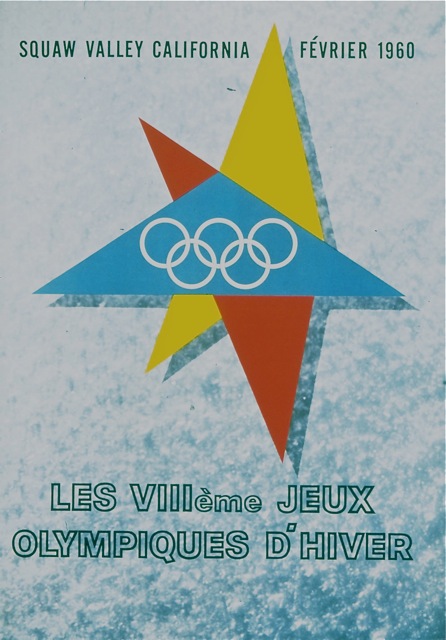 In October of 1966, Walt Disney was declared “Showman of the World” by the National Association of Theatre Owners. His creative legacy was so diverse, spanning so many realms of entertainment and outdoor recreation, it’s remarkable to think that before 1955 he was “merely” a producer of motion pictures. In the last eleven years of his life, the scope of his entertainment empire expanded greatly; the one-time cartoon maker was now a fixture of theme parks and World’s Fairs, of television and sporting events. At the nexus of this activity came the VIII Olympic Winter Games of 1960, where Walt and his creative team expanded the bounds of their activities while forever changing the way the Olympics were presented.
In October of 1966, Walt Disney was declared “Showman of the World” by the National Association of Theatre Owners. His creative legacy was so diverse, spanning so many realms of entertainment and outdoor recreation, it’s remarkable to think that before 1955 he was “merely” a producer of motion pictures. In the last eleven years of his life, the scope of his entertainment empire expanded greatly; the one-time cartoon maker was now a fixture of theme parks and World’s Fairs, of television and sporting events. At the nexus of this activity came the VIII Olympic Winter Games of 1960, where Walt and his creative team expanded the bounds of their activities while forever changing the way the Olympics were presented.
The tale of the 1960 Winter Olympics, held near Lake Tahoe, California, seems itself taken from a fairy tale. Initiated as a publicity stunt by Alexander Cushing, the Harvard-educated owner and only resident of the struggling ski resort, the bid shocked the world by beating out some of the great ski resorts of Europe in International Olympic Committee (IOC) voting in 1955.
The only problem was that the area was hardly prepared to host an international sporting event. At the time it boasted only one chairlift, two tow-ropes and a fifty room lodge. Upon hearing about the California bid, IOC President Avery Brundage told Cushing, “The USOC has obviously taken leave of their senses.” Cushing turned the resort’s size into an advantage, presenting it as a blank slate upon which a world-class facility could be custom built to suit Olympic needs.
Now the newly-formed California Olympic Commission had five short years to build a fully-functional, Olympic-ready facility in the mountains near Lake Tahoe. So undeveloped was the location that at the close of the 1956 Winter Games, the area had no local government to accept the Olympic flag from the mayor of previous host Cortina d'Ampezzo. An IOC member from California had to accept the flag on area's behalf.
Tempting Tinseltown Talent
Bringing the Winter Games to California meant harnessing the luster of Tinseltown. In 1958, Organizing Committee President Prentis Hale visited the Disney studio in Burbank and, after joining Walt for lunch, asked him to become Chairman of the Pageantry Committee for the upcoming Games. This would involve programming the opening and closing ceremonies, the victory ceremonies for each event, and the Olympic torch relay. Disney agreed, saying later, “I didn’t know then what I was getting into!”
Walt was no stranger to the skiing world; Mount Disney in the Sierras was named in his honor after he helped finance the Sugar Bowl resort in 1939, and twenty years later he unveiled his own man-made mountain when the Matterhorn Bobsleds debuted at Disneyland. For the 1960 Winter Olympics, he recruited from within his own organization to build a committee that would undertake a then-unprecedented level of Olympic pageantry. Ron Miller, assistant director at the studio and Walt’s son-in-law, was named Pageantry Coordinator. Another assistant director, Joseph McEveety, was named Olympic Torch Relay Director, and manager Edsel Curry became Director of Special Projects. Walt Disney Productions Vice-President Card Walker was named Director of Publicity. Walt also called upon the talents of a few friends; Art Linkletter, television star and host of Disneyland’s live opening special, became the Vice-President in Charge of Entertainment, and Western Air Lines president Terrell Drinkwater was named Vice-Chairman in Charge of Budget.
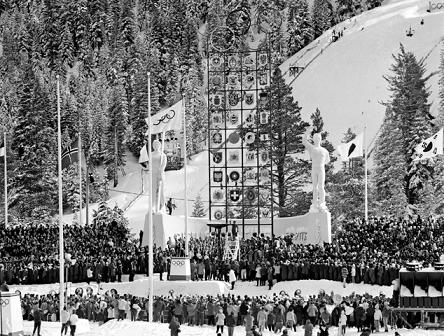 Filling the role of Pageantry Director was Tommy Walker, once bandleader at the University of Southern California and then Director of Customer Relations at Disneyland. Walker hit the road to line up support for the event; he conferred in Salt Lake City with the president of the Music Educators National Conference about recruiting young musicians for the festivities, and sought the help of Japan’s largest fireworks manufacturer in developing the ceremony’s pyrotechnics.
Filling the role of Pageantry Director was Tommy Walker, once bandleader at the University of Southern California and then Director of Customer Relations at Disneyland. Walker hit the road to line up support for the event; he conferred in Salt Lake City with the president of the Music Educators National Conference about recruiting young musicians for the festivities, and sought the help of Japan’s largest fireworks manufacturer in developing the ceremony’s pyrotechnics.
Supervising the musical aspects of the production were Choral Director Dr. Charles Hirt from the University of Southern California and Band Director Clarence Sawhill. After a meeting with the Music Educators National Conference in March 1959, the Committee was granted permission to work with the California and Nevada Music Educators Associations to recruit musicians and singers from public high schools in those states.
The response was overwhelming. When applications were distributed in Fall of 1959, more than thirty bands and seventy choral groups applied to be part of the Olympic ceremonies. After listening to hours of mailed-in auditions, Hirt and his committee selected eighteen bands and thirty-seven choruses from the two states. A musical program was chosen for the event, and in December 1959 Hirt and Sawhill gathered at UCLA to record a demo of the choral and instrumental numbers to distribute to participating schools. Groups practiced first individually, and then in one of four regional rehearsals held in Reno, San Francisco, Fresno and Los Angeles. There was no free ride; students had to raise money back home to fund their trip to the unincorporated area near Lake Tahoe. All told, 3,680 students—1,322 band members and 2,358 choir members—participated.
Youth participation was critical to the success of the Games; acting as official flag-raisers, messengers, and crowd control during the event were 125 Explorer Scouts under the leadership of Scoutmaster William King. Walt himself was quoted as saying, “I have always said that the spirit of American youth cannot be daunted, and I think this was dramatically proven by their unselfish and wholehearted effort before and during the VIII Olympic Winter Games.”
This effort extended to the all-important torch relay, which brought the Olympic flame by foot more than six hundred miles from the Los Angeles Memorial Coliseum—site of the 1932 Olympic Summer Games—to an unincorporated area near Lake Tahoe. More than seven hundred high school runners from the California Interscholastic Federation took part, joined by a number of former Olympic champions. The athletes were each assigned one-mile sections of the route, where they practiced by toting eight pound shot-puts.
Olympic Innovation
Meanwhile, a rush was on to create an Olympics-worthy resort out of the wilderness. It was estimated that two thousand visitors a day arrived in the summer of 1959 to tour the construction site, and Walt himself made several visits to coordinate the entertainment efforts. What he would have found in the works was an Olympics after his own heart—full of innovations and “firsts.”
Previous Olympics had lodged guests and athletes in local hotels and homes, but the remote location of the area necessitated the construction of custom-built housing for participants. Thus, the very first Olympic Village, consisting of four dormitories, was created. Artificial ice was used for the first time in Olympic history for the skating events; waste heat from the refrigeration plant was used to heat buildings, melt snow from roofs, and provide hot water. It was EPCOT on ice.
Other innovations included new timekeeping equipment capable of measuring time to the hundredth of a second; IBM supplied fifteen technicians and two RAMAC computers to tabulate results and output data in English and French. For the first time television rights were sold for the Games, with CBS buying exclusive rights for a mere $50,000. The network eventually broadcast thirty-one hours of coverage during the games, and when officials needed to consult tape of an event to determine whether a skier had missed a slalom gate it inspired the concept of instant replay.
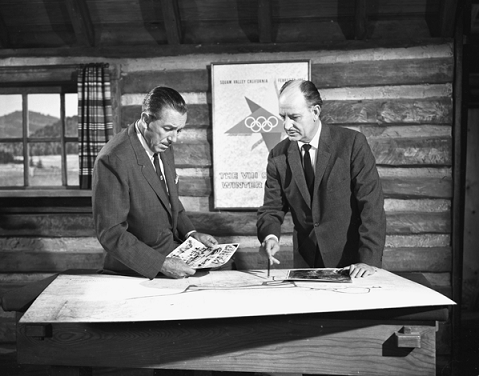 Designing Decor
Designing Decor
The look of the Games was heavily influenced by Disney artist, designer and Imagineer John Hench, who was named Decor Director. At Walt’s suggestion, inspired by the ancient Greek custom of commemorating Olympic champions with marble sculptures, Hench designed thirty sixteen-foot “snow” statues for placement along the Avenue of the Athletes and in other signification locations throughout the area. To learn about snow sculpting techniques, Hench visited the Dartmouth College Winter Carnival and Ice Festival in February of 1959 as well as a similar event in Quebec; he then designed the statues, which were in turn created by Floats Inc. of Pasadena. Nine of the statues were female: four skiers, three figure skaters, and two speed skaters. Among the twenty-one male statues were nine skiers, seven hockey players, three speed skaters, and two figure skaters.
Two larger, twenty-four-foot statues, one male and one female, were created to flank the Tower of Nations. The Tower, another Hench design, stood seventy-nine feet tall and twenty feet wide. Suspended upon the metallic grid which composed the Tower’s frame were the Olympic rings as well as thirty aluminum crests, each five feet by six, denoting the participant nations. The Tower marked the staging area where the opening and closing ceremonies were held, as well as the medal ceremonies for each competition. This was another innovation for the games, as victory ceremonies had not always previously been held for public viewing.
Around the area occupied by the Tower of Nations were thirty aluminum flagpoles, one each for the thirty participating nations. The effort to build the facilities was an expensive one, so sponsorships took on an importance previously unknown in Olympic history. To help offset the tens of millions of dollars in construction costs, corporations, cities and individuals were approached to sponsor individual flagpoles and snow sculptures; sponsor names were engraved on the items, and they were allowed to claim them after the Games had ended. For $2,000 one could purchase one of the snow statues; Palm Springs, Pasadena, Burbank and Inglewood were among the cities that agreed to do so. Today, some of the flagpoles can be found in locations as widespread as the Walt Disney Studios Commissary in Burbank, the Walt Disney Elementary School in Marceline, Missouri, and at the first tee of the La Quinta Country Club in La Quinta, California.
Disney also helped fund a “symphonic carillon,” which rang out three times a day and could be heard throughout the valley. Installed by a Los Angeles electronic engineer, the 161-bell carillon and 61-note vibrachord harp used twenty-four speakers and was provided to the Olympic committee without cost.
One lasting Hench contribution to the Olympic legacy was the torch. While torches had been used in previous Games, Hench completely redesigned the version used in 1960. Subsequent Games have adapted their torches to local cultural traditions, but their overall forms all hearken back to Hench’s design.
Olympic Challenges
Yet all did not go smoothly in the run-up to the Games. Walt had originally announced plans for the Torch to be flown from Olympia, Greece by “jet airliner” to Los Angeles, but the Greek Olympic Committee did not receive a request to ignite the flame at Olympia until January 1960 and refused to do so for logistical reasons. A last minute shuffle in the plans meant a return to the ritual followed during the 1952 Winter Games in Oslo, wherein the Torch was ignited at the chalet of Norwegian skiing pioneer Sondre Nordheim.
Also uncooperative were officials in Melbourne, Australia, site of a recent Olympics, to whom Disney technicians wrote for a formula that could fuel the Torch throughout the Games. The Australians refused to divulge their secrets, so Disney staffers had to concoct their own fuel mixture.
Even the avian community caused trouble; it was the first Winter Olympics to feature a release of doves at the opening ceremony, but it was worried that doves would linger in the valley and freeze to death. Homing pigeons were recruited to play the role of “doves of peace,” since they would know to leave the valley and return home after they were released. This troubled the fellow in charge of the ice rink, who was wary of releasing thousands of nervous birds over his pristine ice. The schedule of events was shuffled so that the ceremonial cannons would fire only after the pigeons had been released and were heading for home.
More complications came when it was decided to use the original Olympic Anthem that had been written for the first modern Games in Athens in 1896. The Disney musical department attempted to obtain a score from Olympic headquarters in Switzerland to no avail. Eventually they were able to track down a copy in Japan, but it was in Japanese and they had to decipher it as best they could.
Hench’s giant snow statues encountered trouble on the way from Pasadena; a tarp on one of the diesel trucks transporting them came loose, and its exhaust covered the white statues with soot. Bob Henry, executive vice president of Floats Inc., who had been tasked to build and deliver the statues, was forced to find a way to wash them as quickly as possible. After delivery, 100-mile-an-hour winds at the Olympic site blew one of the statues over; the press reported that Henry soon left for New York so as to get as far away from the statues as possible.
At last, the time for the Games neared. California’s Racing Pigeon Organizations visited to make trial runs with their “doves of peace.” The day before the ceremony, the combined bands had their first group rehearsal. Four Army cannons, firing four-inch shells, were brought in and aimed at surrounding mountains to prevent avalanches, yet it was a torrential rain the week before opening that threatened to wipe out the packed-snow parking lots that had been so carefully created for visitors.
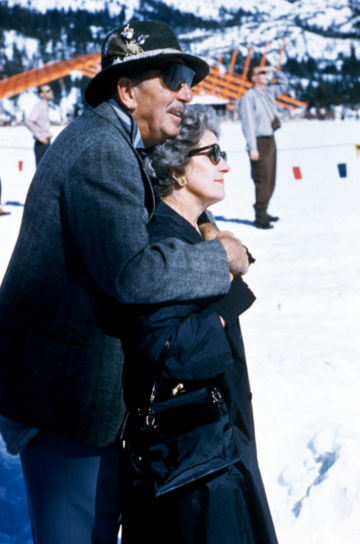 Let the Games Begin
Let the Games Begin
The Olympic Torch, which had departed Morgedal, Norway—the “cradle” of winter sports—on January 31st, was carried above the North Pole by an S.A.S. DC-7 to Los Angeles. Passed at Los Angeles International Airport to Olympic shot-put champion Parry O’Brien, it was taken via helicopter to Los Angeles Memorial Coliseum where it began its journey to the area by foot in the pouring rain. Over a period of nineteen days it traversed a route scouted personally by McEveety, past small towns that greeted it with celebrations and festivities along the way.
On February 18th, 1960, Walt Disney and his staff awoke and were greeted by a blizzard. With the ceremony—and coast to coast television coverage—scheduled to begin at 10 AM, the whiteout conditions presented several difficulties. Snow on the roads prevented people from making the perilous drive to this unincorporated area near Lake Tahoe and hindered the network crews and announcers from reaching their locations.
Ten inches of snow fell that morning; CBS host Walter Cronkite appeared to have been broadcasting from the Arctic wastes. Many of the high school musicians hadn’t dressed properly for the conditions, and stood freezing to their instruments during dress rehearsal—not that they could see the conductor through the snow anyway. The pigeon wranglers insisted that they couldn’t release their birds in such weather. And Vice President Richard Nixon, assigned to proclaim the opening of the games, was forced to drive in from Reno as his helicopter couldn’t operate under the conditions. No one knew if he was going to make it on time.
Someone had to decide what to do. The alternative to an outdoor ceremony was a much smaller indoor ceremony, which the TV crews favored, but Dr. Charles Hirt, the choral director, objected to having to leave out so many of the young musicians who had worked so hard to be a part of the festivities. Art Linkletter later reported that Walt remained unfazed throughout; Disney merely said that they would go on and it would hopefully clear up. Walt even press ganged Linkletter into service as a television host, despite the fact that he was not meant to be there as a broadcaster. But although the ceremony was postponed fifteen minutes to allow more spectators to arrive on the snowbound roads, where bumper-to-bumper traffic extended for twelve miles outside of town, they couldn’t stall forever.
Finally, with everyone gathered and ready to go, the skies cleared. To everyone’s astonishment, the snow ended and the sunshine began, and the opening ceremonies of the VIII Winter Olympics were underway.
The festivities began with a sustained drum roll and the raising of the thirty national flags, as the United States Marine Band played “The Parade of the Olympians.” The 740 athletes then entered the arena, with each national delegation heralded by a salvo of fireworks. This was advertised as the first-ever use of daytime fireworks, a Disney tradition that continues in the theme parks today.
After the athletes were seated, Prentis Hale, President of the Olympic Organizing Committee, delivered a welcome. The 1960 Winter Olympics marked the first Olympics of the Space Race era, and Hale’s speech acknowledged the nationalist tensions that had marked the preparations for the games:
“You can return home as the world’s best-equipped ambassadors of unity and peace. Before we pay so much attention to conquering outer space, we should devote ourselves to conquering inner space: the distance between nations.”
Avery Brundage, President of the IOC, then introduced Vice President Nixon who declared the games open; Nixon had driven forty-six miles through the snow from Reno to deliver a fifteen-word address. The massed band and chorus joined the Marine Band in playing the newly-orchestrated Olympic Hymn, the first time the 1896 piece had been presented at a Winter Olympics. Two thousand pigeons were released, and once they were clear there was an eight-round cannon salute—one salvo for each of the previous Winter Olympic Games. A newly-composed piece, “These Things Shall Be,” was then performed by the massed bands and chorus.
Once planned for delivery by helicopter, the Olympic Torch made the last thirty miles of its route via cross-country skier. It arrived on-site courtesy of Olympic champion Andrea Mead Champion, who appeared with the flame atop the peak of Little Papoose and blazed down the slopes accompanied by an honor guard of eight skiers to deliver the Torch to Olympic speed skater Kenneth Henry. As the massed bands played the piece “Conquest,” Henry lit the ceremonial torch, officially beginning the Games.
Chimes rang throughout the hills, and as the Marine Band performed “God of Our Fathers,” participants joined in the Olympic prayer, which was narrated by actor Karl Malden. This was a somewhat controversial decision at the time, as such an event had not always been included in previous Olympics. There might have been a bit of Cold War showmanship at play here; Tommy Walker was quoted as saying that the prayer was optional, but “Walt felt that prayer represents one of the freedoms of America and that we should definitely have it.”
After the prayer, American figure skater Carol Heiss recited the Olympic oath on behalf of all the athletes, the first female Olympian to ever do so, and the assembled bands performed a new orchestration of “The Star-Spangled Banner.” The ceremony ended, appropriately, with a bang; as the athletes paraded out, 30,000 balloons were released and shells were fired that exploded with bursts of flags from each nation, which drifted back to earth via parachutes.
Five minutes after the end of the ceremony, the snow began to fall once more.
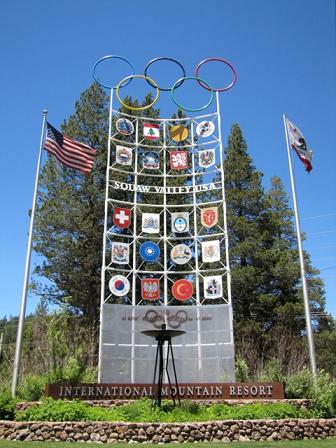 While the 6,500 spectators fell short of projections due to the weather and traffic, the show delivered as promised. But even with all the rave reviews, Walt still had tricks up his sleeve. The 1960 Olympics were the first to be scheduled with live entertainment for the athletes in mind, and when Walt first announced his plans he proclaimed that “nothing is more important than creating lasting goodwill among our visitors, and we shall do everything we can to make their stay a happy one.”
While the 6,500 spectators fell short of projections due to the weather and traffic, the show delivered as promised. But even with all the rave reviews, Walt still had tricks up his sleeve. The 1960 Olympics were the first to be scheduled with live entertainment for the athletes in mind, and when Walt first announced his plans he proclaimed that “nothing is more important than creating lasting goodwill among our visitors, and we shall do everything we can to make their stay a happy one.”
Again, he delivered. Entertainment Vice-President Art Linkletter brought in a slew of his Hollywood friends every evening, resulting in appearances by Bing Crosby, Roy Rogers, Red Skelton and Jack Benny. Actress Marlene Dietrich posed for pictures with the German hockey team, and the media was well tended to, thanks to “official press hostess” Jayne Mansfield. The Academy of Motion Pictures Arts and Sciences delivered films for the athletes, which were presented (along with free refreshments) nightly in the enclosed Olympia Theater.
A standout favorite was actor Danny Kaye, who managed to lead a number of international delegations in a chorus of “Row, Row, Row Your Boat.” Press reports from the time describe Kaye performing rollicking musical numbers in a dozen languages, working Korean, Japanese, and Russian participants into his act. Decades later, many of those in attendance remembered having been in tears over Kaye’s antics.
One memorable evening, Walt brought up the entire Golden Horseshoe Revue from Disneyland to present to the Olympians. Wally Boag, Betty Taylor, Gene Sheldon, Henry Calvin, Don Novis and three stuntmen all performed to a rapt audience, and the staged “saloon brawl” at the end of the evening was so raucous that the media reported a frightened security officer had rushed to the phone to summon help.
Walt had one last idea for entertaining the participants, who due to their own busy schedules rarely got to see the medal ceremonies as they took place. So every evening, while emceeing that night’s entertainment lineup, Linkletter would introduce the new champions who had won medals that day. They would then have a drawing, with the winner getting a free phone call home—a rather remarkable prize in those days. One evening the winner was said to be so excited that he could barely speak, and it was only when they got through to his hometown operator that he remembered his family didn’t own a telephone.
After ten days, 665 athletes from thirty nations had competed in twenty-seven events, and it was time to return home. On February 28th, 20,000 spectators filled the stands of Blyth Memorial Arena to witness the closing ceremonies. Flag bearers surrounded the rostrum as the nation anthems of Greece, the United States, and Austria were played. IOC president Brundage declared the games closed, and the Olympic torch was extinguished. Thousands of balloons were released to end the ceremony.
Rave Reviews
Disney’s Olympics, the largest Winter Games held to that point, received rave reviews. The once-skeptical IOC chair would go on to say they were the “greatest games ever staged.” Army Archerd, in Variety, called Disney’s opening ceremony “the greatest show on Earth,” and a reporter for the Los Angeles Times proclaimed that “It is my conviction that you’ll never see anything of that kind so well done in your lifetime.” Even the Russians were impressed; one of the heads of their delegation approached an Olympic security chief and asked what chemicals had been used to control the weather during the opening ceremony.
The 1960 Winter Olympics would cast a long shadow, influencing the look and feel of the Games up to this day. Many of Disney’s team would contribute to future Olympics, most notably the 1984 Summer Olympics in Los Angeles. The events of the Olympics would also affect Walt; it marked the first time he had met the world outside of Disneyland, and in a way began the outreach efforts he would continue in 1964 at the New York World’s Fair. It also sparked a concerted effort to build his own winter sports resort at Mineral King, a project he would pursue for the rest of his life.
But at the time many simply wondered how Walt had managed to make things work out so perfectly. Was it divine intervention? Some sort of nationalist statement from the gods of Olympus? In Disney’s own press materials they claimed that if it was a miracle, it was a well-planned miracle. But perhaps Walt said it best; according to Linkletter, after the improbably perfect opening ceremony Walt explained it thus: “It’s just that if you live right, things happen the way they’re supposed to."
Michael Crawford is a writer and historian with a lifelong fascination with Walt Disney, his works, and his creative legacy. He is the author of Progress City, U.S.A., a website devoted to uncovering the history of The Walt Disney Company as well as promoting Walt's creative ethos.
On Saturday January 21 at 3:00pm, Urban Planner and Community Engagement Specialist Sam Gennawey hosts past Disney CEO and Museum Founder Ron Miller and architect David Price to discuss Mineral King: Walt’s Lost Last Project, the innovative (and now-forgotten) year-round mountain resort that was one of Walt’s last major projects.
Third Man on the Mountain screens daily through January at 1:00pm and 4:00pm (except Tuesdays, and January 21 and 29). Tickets are available at the Reception and Member Service Desk at the Museum, or online by clicking here.
Images above: 1) The official poster featured the Winter Games logo with text in all the languages of the participating countries. 2) The Olympic Gateway and Snow Sculptures, supervised by John Hench. 3) Walt and Decor Director John Hench. © Disney. 4) Walt and Lilly enjoy the Olympic events together. 5) The Olympic Gateway today has been restored to resemble its original design.
